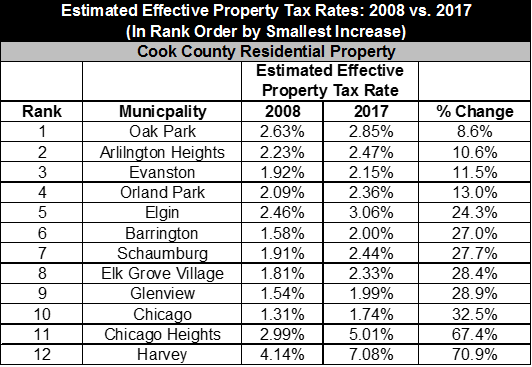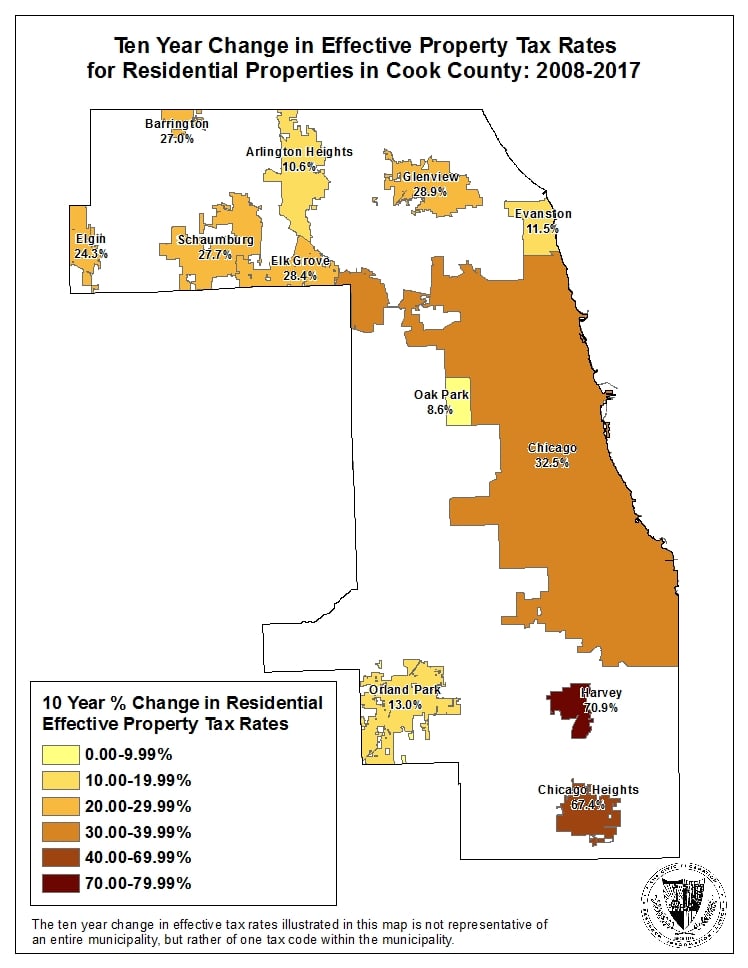November 01, 2019
The Civic Federation recently released its annual Effective Property Tax Rates report, which examines two- and ten-year trends in estimated effective tax rates for residential, commercial and industrial property in selected northeastern Illinois communities. The report highlights that in the ten-year period between tax years 2008 and 2017, the effective tax rates increased in all of the selected communities in Cook County and the collar counties (Lake, McHenry, Kane, DuPage and Will), except industrial properties in the City of Chicago, since there were not enough sales of industrial property in tax year 2017 to calculate an effective tax rate. This blog will specifically look at the ten-year trend for residential property in Cook County.
An effective property tax rate is an estimate of the percentage of a property’s full market value owed in property taxes during a given tax year. It offers a method of comparing property tax burdens across municipalities and counties. For example, the report shows that in 2017 the estimated effective property tax rate for property owners in a selected tax code in Orland Park in Cook County was 2.36%. More simply stated, in 2017 a residential property owner in that particular tax code in Orland Park with a property worth $200,000 would have an estimated property tax bill of $4,720 in property taxes without any exemptions.[1]
The table and map below show the percent change in effective property tax rates for residential property in the ten-year period between tax years 2008 and 2017 for selected communities in Cook County. Over this time period, every selected Cook County community experienced an increase in effective property tax rate for residential property, with increases ranging from 8.6% in Oak Park to 70.9% in Harvey. Two of the three south suburban communities studied—Chicago Heights and Harvey—experienced the most dramatic increases in their effective tax rate for residential property in this period, with increases of 67.4% and 70.9% respectively, due in large part to a shrinking tax base in both communities.


While estimated effective property tax rates cannot be used to accurately determine the precise tax burden on specific properties, they are useful for providing an apples-to-apples comparison of average property tax burdens in different areas over time. To take the most extreme example from the table above, a residential property owner with a home worth $100,000 in a selected tax code in Harvey with a 4.14% effective property tax rate would pay an estimated $4,140 in property taxes in tax year 2008 without exemptions. In tax year 2017, the same home in Harvey worth $100,000 would owe an estimated $7,080 in property taxes if they were not eligible for exemptions. In the ten-year period from tax year 2008 to tax year 2017, the effective property tax rate in Harvey increased from 4.14% to 7.08%.
Change in effective tax rates over time is due to changing actual composite tax rates, changing median levels of assessment, or both. In Cook County, effective tax rates can be affected by changes in the Cook County equalization factor as well.[2]
In the case of Harvey, all three factors contributed, but a significant increase in the actual composite tax rate drove most of the increase in the effective tax rate. The actual composite property tax rate in Harvey increased from 14.661% in 2007 to 26.062% in 2017, again due in large part to a falling property tax base. Over the same time period, the median level of assessment as calculated by the Illinois Department of Revenue decreased from 9.49% to 9.17% for residential properties.[3] The increasing trend in property tax rates is by no means consistent over time. Between tax years 1999 and 2006 every selected Cook County community experienced a decrease in its effective property tax rate for residential property, with changes ranging from -18.9% in Chicago Heights to -2.7% in Harvey.
Related Links:
Estimated Effective Property Tax Rates 2008-2017: Selected Municipalities in Northeastern Illinois
Calculate Your Community’s Effective Property Tax Rate
Estimated Full Value of Real Property in Cook County: 2008-2017
School Districts and Property Taxes in Illinois
The Final 2018 Cook County Equalization Factor is 2.9109
[1] Property tax exemptions available to eligible homeowners reduce the taxable value of their property.
[2] The collar counties’ equalization factors do not generally change significantly from year to year because they do not set different property tax assessment levels for different types of property. Cook County is the only county in Illinois that uses differential assessment, also known as classification.
[3] 2017 Information provided by the Illinois Department of Revenue and information contained in Assessment Level Ratios from previous years, available at https://www2.illinois.gov/rev/research/taxstats/PropertyTaxStatistics/Pages/default.aspx
